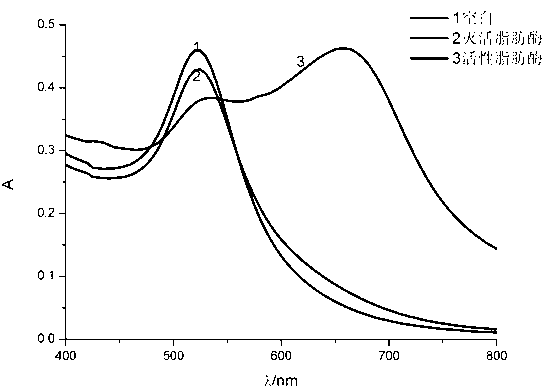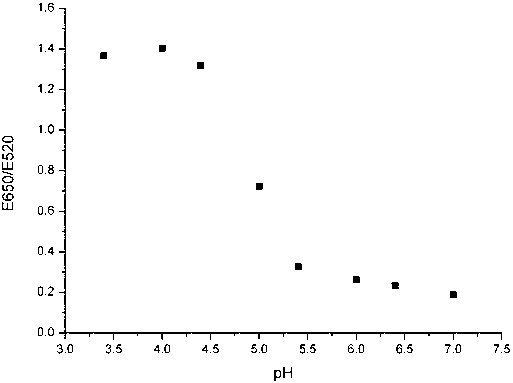Method for detecting lipase activity
A technology of lipase and activity, which is applied in the field of analytical chemistry, can solve the problems of complex preparation of solutions, dependence, and inconspicuous color changes, and achieve the effects of large-scale use, reduced experimental errors, and good water solubility of substrates
- Summary
- Abstract
- Description
- Claims
- Application Information
AI Technical Summary
Problems solved by technology
Method used
Image
Examples
Embodiment 1
[0035] (1) Preparation and characterization of nano-gold solution
[0036] First, accurately weigh the HAuCl 4 .4H 2 O 0.0123 g was dissolved in 100 mL deionized water, and then added to a 250 mL fixed three-neck flask. Stir vigorously and heat to reflux. Then accurately weigh 0.2849 g of sodium citrate and dilute to volume in a 25 mL volumetric flask. After the water bath was heated to 50 °C, a certain volume of sodium citrate solution was accurately pipetted into the flask with a pipette. The solution changed from colorless to light blue to purple and finally to wine red. Continue heating for 10 minutes, then stop heating, continue stirring for 10 minutes and then cool to room temperature to obtain the required 13 ± 2.5 nm gold colloid. The diameter of gold nanoparticles was finally determined using a transmission electron microscope (JEOL JEM-200CX, Japan).
[0037] (2) modifying the nano-gold solution obtained in step (1) with methyl thioglycolate to obtain a function...
Embodiment 2
[0040] The method for visually detecting lipase activity based on gold nanoparticles described in this embodiment comprises the following steps:
[0041] (1) adopting sodium citrate reduction chloroauric acid to make concentration is the wine red nano-gold solution of 2.5 nmol / L,
[0042] (2) Modify the nano-gold solution obtained in step (1) with methyl thioglycolate to obtain a functional nano-gold solution; wherein, the molar ratio of nano-gold and methyl thioglycolate modification is 1:60; the modification time is 24h;
[0043] (3) Add a buffer solution to the nano-gold solution obtained in step (3) to adjust the pH, adjust the pH to 4.5; then add the lipase solution to be tested, mix well, adjust the reaction temperature to 35 ° C, and carry out the solution Detect, get the UV-Vis spectrum corresponding to different times, and then use the absorbance ratio E 650 / E 520 As the ordinate and time as the abscissa, draw the kinetic curve of lipase activity 。
Embodiment 3
[0045] The method for visually detecting lipase activity based on gold nanoparticles described in this embodiment comprises the following steps:
[0046] (1) adopting sodium citrate reduction chloroauric acid to make concentration is the wine red nano-gold solution of 1.8 nmol / L,
[0047] (2) modifying the nano-gold solution obtained in step (1) with methyl thioglycolate to obtain a functional nano-gold solution; wherein, the molar ratio of nano-gold and methyl thioglycolate modification is 1:40; the modification time is 1h;
[0048] (3) Add a buffer solution to the nano-gold solution obtained in step (3) to adjust the pH, adjust the pH to 4.0; then add the lipase solution to be tested, mix well, adjust the reaction temperature to 45 ° C, and carry out the solution Detect, get the UV-Vis spectrum corresponding to different times, and then use the absorbance ratio E 650 / E 520 As the ordinate and time as the abscissa, draw the kinetic curve of lipase activity 。
[0049]
...
PUM
 Login to View More
Login to View More Abstract
Description
Claims
Application Information
 Login to View More
Login to View More - R&D
- Intellectual Property
- Life Sciences
- Materials
- Tech Scout
- Unparalleled Data Quality
- Higher Quality Content
- 60% Fewer Hallucinations
Browse by: Latest US Patents, China's latest patents, Technical Efficacy Thesaurus, Application Domain, Technology Topic, Popular Technical Reports.
© 2025 PatSnap. All rights reserved.Legal|Privacy policy|Modern Slavery Act Transparency Statement|Sitemap|About US| Contact US: help@patsnap.com



